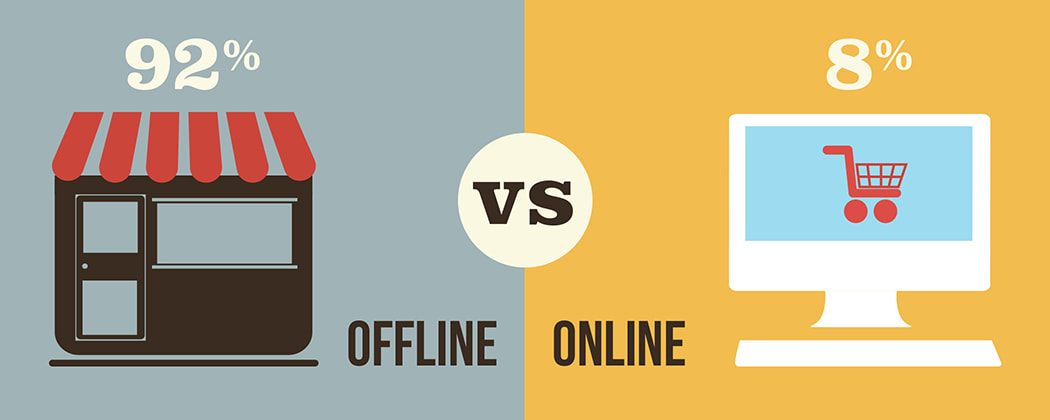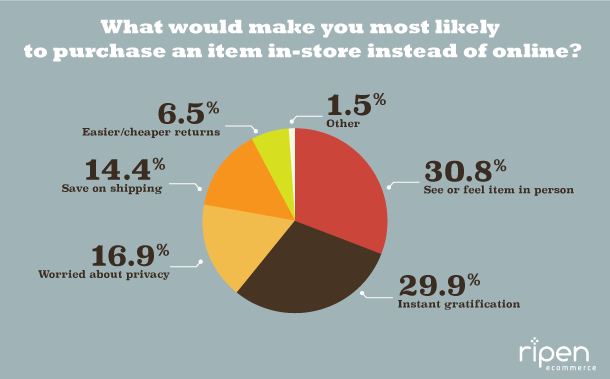Study: Why 92% of Retail Purchases Still Happen Offline

You’ve heard it before, possibly even on this blog: ecommerce is absolutely huge, and it’s growing at phenomenal rates.
Yet the vast majority of US retail sales, 92%, still happen offline. That’s right – ecommerce’s huge, crazy, insane growth still only represents 8% of the total retail market.
Of course, 8% of a $3.2 trillion industry is still nothing to sneeze at. And with room for more than tenfold growth, the ecommerce market is ripe (sorry) with opportunity for anyone who can uncover and capitalize on the factors holding consumers back from shopping online.
If only a particularly data-driven company had done research on the subject. Oh wait…we did.
Using Google Consumer Surveys (which was one of the most reliable polling systems for the 2012 US presidential elections), our analysts polled 1235 American shoppers to discover the number one thing keeping them offline.

30.8% said they want to see or feel products in person.
It should come as no surprise that the chief reason consumers don’t like virtual shopping is because you just can’t feel pixels. Gauging the quality, fit, ergonomics, or weight of a product is simply easier in person – and this obviously isn’t something that can be simulated 1:1, at least not yet.
What you can do
Don’t get any crazy ideas about 3D printing or virtual reality, but do get ideas about getting your products in customers’ hands.
- Send free samples. Take deliberation out of the equation by sending prospects something they can try out. Birchbox took this approach and now has a 50% conversion rate!
- Use the puppy dog approach. Let users “take home” a product with the expectation they can return it absolutely free, no hassles. Throw in a guarantee, free return shipping, or anything else that makes it easy to fall in love with what you’re selling. But please don’t mail any actual puppies.
29.9% of survey respondents want their items right away
If instant gratification isn’t a hallmark of consumerism, we don’t know what is. When customers want a product, they want it fast – and being able to pounce on the purchasing window while it’s open is a big deal. Jimmy John’s gets sandwiches to sub-lovers faster than they could pick them up, which is so fast nobody even thinks about whether the food is any good.
What you can do
Same day delivery may not be realistic for every company, but even light offerings can make a big difference for your business.
- Solve it on a small scale. Even the companies offering same-day delivery focus on manageable areas of operation. Case in point: the Seattle-only launch of Amazon Fresh. If you could ship same-day within 25 miles of your fulfillment center, it would mean the world to your nearest buyers.
- Get the word out. Once you’ve established an area of same-day operation, up your local PPC advertising to let customers know.
16.9% said shopping offline helps protect their privacy
You don’t love it when companies constantly mail, text, retarget, or generally creep on you, so why would your prospective audience? People want to feel secure while browsing and buying, so anything you can do to bolster a sense of privacy helps.
What you can do
- The option to opt-out. Encourage users to let you know when things get too clingy, whether it’s an email list or various add-on services.
- Provide guest checkout. Consumers don’t want to give out personal data unless it’s strictly necessary – plus this win-win option has been proven to boost conversion.
- Less fine print. Prominently display your privacy and security policies throughout your site. And if you don’t have any, you should probably get around to writing them.
- Actually bolster security. Talk is one thing, but upping your on-site protection is better. Review your checkout process, data storage techniques, and security practices to ensure your store’s locked down.
14.4% of americans buy in-store to save on shipping costs
Buying online is significantly more cost-efficient than traditional shopping… except when it comes to getting something out the door. And while 14.4% may not sound high, ignoring up to a sixth of your audience isn’t a great plan, either.
What you can do
- Free shipping. Offering free shipping is an obvious, albeit potentially expensive, solution. Even if you have to build the cost into product pricing, the magic of seeing “free shipping” is enough to convince many shoppers.
- Don’t double-dip on delivery. Yes, you can make a lot of money by placing a markup on shipping. But in the long run, it’s only going to turn off potential customers while giving competitors an easy way to undercut you.
- Do an experiment. Send 10% of your customers a notice that they’ve been upgraded to a premium status that receives free shipping. Then monitor their long-term purchase value versus your controlled base. You may be surprised just how much more you make by eliminating the shipping cost barrier.
6.5% of consumers prefer offline due to easier/cheaper returns
Returns are an unfortunate but inescapable fact of the retail world, so it may seem like the best bet is making exchanges and refunds harder. You may have had some one-off experiences that really hurt your bottom line, as well. But in today’s world, you’re fighting an uphill battle – shoppers expect a pain-free return experience.
What you can do
Don’t get caught up in anecdotes of irate customers. Focus on strategies that will keep most of the people happy most of the time.
- Create and publicize a great return policy. Whether or not individual customers take advantage of your offer, everyone’s more likely to buy when they know about and trust in a store’s return policy.
- Do another experiment. Include pre-paid return labels in a small percentage of your shipments, then see if customers end up returning more products. If so, how much? And do they come back to buy again?
Converting customers to ecommerce
The transition from in-store sales to online shopping isn’t going to happen overnight, but with so much room for growth (and so many clear-cut avenues for improvement) there’s no reason digital retail can’t make significant headway.
Want more ecommerce insights? Check out Ripen’s AdWords white paper and cut down on wasted ad spend or take a look at our retargeting guide and get in front of qualified consumers.
Let’s get started.
Find out how we can help your ecommerce strategy.
Get in touch
If you’re a rockstar with big ideas, join our team.




